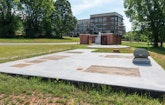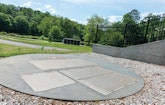Interested in Infrastructure?
Get Infrastructure articles, news and videos right in your inbox! Sign up now.
Infrastructure + Get AlertsVery few American communities find themselves with the right infrastructure in place for the century to come. Greenville, South Carolina, may be the exception.
Greenville is in South Carolina’s Upstate Region, about halfway between two of the largest cities in the Southern U.S., Charlotte and Atlanta. The community has seen its population grow by 27% since 2000, but a recently completed wastewater conveyance project has ensured that this fast-growing community is poised to accommodate another 100 years of growth.
The Dig Greenville project, also called Reedy River Basin Sewer Tunnel, consisted of a 1.3-mile, gravity-fed sewer line. Work on the $46 million project started in 2018 and concluded in the spring of 2022.
“It definitely puts not just the downtown, but rather the whole city in a better position for the future,” Mayor Knox White said when the project was introduced in 2016.
The underground tunnel is the largest infrastructure project in Greenville’s history. Renewable Water Resources, a 97-year-old organization that protects the region’s waterways and wastewater infrastructure, spearheaded the effort. Black & Veatch led the design and provided construction management services.
“Dig Greenville is one of the most important infrastructure investments needed to ensure economic growth in the area,” said Graham W. Rich, chief executive officer of ReWa when the project started. “With this investment and hard work, sewer lines and the area along the Reedy River will be at lower risk for sewer overflows, especially when rainfall is high. This investment and work were also required to ensure Greenville’s future economic development since, without it, no additional wastewater flows could be added to the existing lines.”
Capacity need
The existing sewer line in Greenville followed the Reedy River basin through the city’s downtown district. Near capacity, it faced pressure from Greenville’s recent and projected population growth. Without more capacity, the community would be at risk from increased overflows. That risk posed a direct threat to water quality, the environment and economic development.
“If nothing is done, ReWa’s sewer lines and the area along the Reedy River would be at a higher risk for the environmental impact of sewer overflows,” Rich says. “Furthermore, economic development would be threatened because no additional wastewater flows can be added to the sewer lines. While the project is a long-term fix, Dig Greenville will also meet immediate needs by providing an increased buffer against sewer surcharges due to inflow and infiltration during rain events.”
ReWa considered 18 alternatives before deciding on the gravity sewer tunnel. Rebuilding the sewer line was prohibitive and too disruptive to the city and water basin. ReWa chose to install the new line underground, approximately 100 feet below the heart of the city.
“While it is pricier to build, a deep sewer tunnel powered by gravity will be far less costly over its lifecycle for ReWa while providing the reliable additional capacity Greenville needed as it continues to grow,” says Joel Jones, who took over as ReWa executive director from Rich earlier this year.
Project centerpiece
The tunnel is the project centerpiece. It is 7 feet in diameter and virtually invisible to the public. Entry shafts at each end are the only hint of the massive pipe under the surface. The pipes are encased in granite, lined with fiberglass and grouted. The gravity-fed system requires no mechanical equipment to convey the flow of wastewater.
“The tunnel is bored from one end, resulting in surface impact only at either end of the tunnel, rather than all along the sewer route if conventional construction methods were used,” Jones says.
The initial plan was to drill from the downstream access shaft through the hard rock below with a tunnel boring machine. Before the TBM could be launched, however, a geotechnical investigation found the tunnel zone was comprised of soil and different types of rock in varying conditions.
“The tunnel boring machine can only work through one type of material,” Jones says. “Right when we were getting started, we saw that the granite was not where we thought it was.”
The complication resulted in hand-digging a starter tunnel. Starter tunnel construction also included drill and blast methods that required 41 blasts over a nine-month period. Each blast was modified to fit the zone’s complex geology. Workers also fabricated and installed a customized steel shield to secure ground support for the 14-foot-round horseshoe-shaped starter tunnel.
“What we found was about 240 feet of clay and rock that we had to dig out,” Jones says.
“It cost us about 10 months of project time. The tunnel boring machine can dig out about 40 to 50 feet per day. We were only digging out about 2 feet per day. It was very time-intensive and labor-intensive just to get started.”
Picking up the pace
A massive tunnel boring machine helped workers pick up the pace after completing the starter tunnel.
The boring machine, known in the Greenville community as “Drilly,” carved out the majority of the tunnel. The 130-ton machine, made by The Robbins Company in Canada, measures 249 feet and is one of only a handful of similar pieces of equipment in the world. Super Excavators of Wisconsin started digging the tunnel in March 2018 and completed their work in September 2020.
The boring machine was critical to the completion of the project in that it offered a far more efficient drilling method. Boring machines are used as an alternative to drilling, blasting and hand-mining to excavate tunnels with a circular cross-section through layers of soil and rock.
The machines significantly minimize disturbance to the surrounding ground and area. They are frequently used in urban areas and reduce project completion times.
The boring machines consist of a rotating cutting wheel, a main bearing, thrust system and trailing support mechanism. Steel blades chip away at the soil and rock as the head rotates. As the TBM advances, a conveyor belt within the trailing gear transports soil or rock back to a locomotive connected to cars positioned at the end of the trailing gear. The locomotives haul rock back to the shaft for removal from the tunnel.
“Once we got through digging the starter tunnel, we stayed on a fairly good track,” Jones says.
Out of sight
For a project of this magnitude and duration, workers were surprisingly able to stay out of the public glare. Almost all the construction took place underground, out of sight of city residents.
Teams constructed wooden fencing around the construction to minimize the aesthetic impact of the project. During a two-month winter period, one roadway was closed off to facilitate quicker construction for a sewer crossing of Richland Creek and to accommodate the city’s streambank restoration project.
While largely hidden from the public, the beginning and end points of the construction are identifiable by access doors.
The BILCO Company manufactured 13 floor access doors of various sizes for the project. The doors allow access to vertical shafts — one is 35 feet deep, the other is 105 feet deep — in which workers descend or lower equipment into the tunnel.
“We use those types of doors fairly often on our projects, especially at pump stations,’’ Jones says. “We find they have good durability and reliability.”
But while most of the work was hidden, ReWa made sure to maintain a dialogue with city residents. The construction sites were near city residences and a local zoo. Residents were understandably concerned about how the project would impact their quality of life.
“We put in a good bit of effort to educate the public, get their feedback and learn what they had concerns about,” Jones says. “We wanted to gain the trust of the community from the very beginning. We had a series of meetings where we showed the community that we were serious about their concerns and taking them into consideration.”
On time, on budget
Large-scale infrastructure projects frequently experience overruns in budget and time. The Dig Greenville project experienced a setback in drilling the starter tunnel but that was the only hiccup in a multiyear project that also included fallout from a global pandemic.
“We had to add about 10 months due to the schedule, but we were able to keep it within the original project budget,” Jones says. “We were able to find some cost savings in some other areas and we had some good bids when we started.”
The most important objective, however, was giving Greenville the wastewater conveyance infrastructure to help the community build for the next century.
“It’s been a challenging project, but a fun one to be involved with,” Jones says. “It’s a good feeling to know that we’re contributing to the long-term viability of the community. It took a lot of work to make it a success, and it came about through the efforts of a large group of people.”











